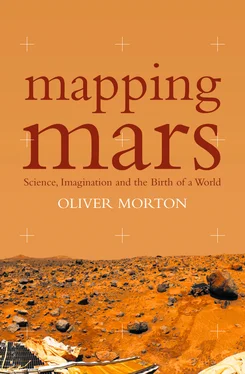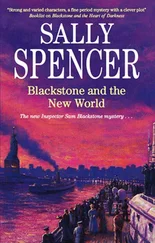Two days later, after the spacecraft had gone into orbit, new pictures revealed that each of these spots had a crater at its centre. Carl Sagan took a Polaroid of the computer screen and rushed to the geologists’ room. Masursky and his colleagues immediately realised what they were seeing. These were not impact craters like those seen by the previous Mariners, but volcanic calderas. Nix Olympica and the other features – dubbed North Spot, Middle Spot and South Spot – were volcanoes, volcanoes vast enough to stick out of the lower atmosphere into air too thin to carry the fine Martian dust. Within hours, Masursky was telling the waiting press corps all about it. Murray, who as well as sporting the black trunks of the killjoy was taking on a role as the television team’s prudent conscience, was aghast. Mars had previously shown no signs of volcanism; it was surely rash to jump to such a dramatic conclusion. But within days more detailed photos showed without doubt that Masursky was right.
It’s easy now to scoff at Murray’s reluctance to see the truth. Mars’s volcanoes have become, along with its vast canyon system, the things for which the planet is best known. Inasmuch as there is a popular picture of Mars today, these features – four big lumps with a long set of deep gashes to one side, rendered in a reasonably garish red – are what make it up. In some ways, though, Murray’s reluctance to credit such things seems almost fitting, a greater tribute to their stature than straightforward acceptance. It may sound like a lack of imagination – but if you wanted to, you could read it as the opposite. Maybe Murray had the imagination to look beyond the simple images of calderas and see quite how dauntingly huge the volcanoes would have to be in order to show up on Mariner 9’s pictures of a planet wrapped in dust from pole to pole.
Think of the commute that some of the USGS astrogeologists were making on a weekly basis between San Francisco and Los Angeles; like a few thousand people every day, I made it myself while researching this book. You come off the tarmac at San Francisco airport and wheel round over the South Bay; northern California drops away beneath you, views open up. By the time the plane is at its cruising altitude of 33,000 feet, the view has spread out across the state. The Coast Range beneath you is a set of soft creases in the earth’s crust, the Sierra Nevada a white rim on the horizon. After about half an hour’s flight at a fair fraction of the speed of sound, you start to drop down and pull out over the Pacific, then come back around into LAX. And if your plane could fly through solid basalt, that entire flight profile would fit easily inside the bulk of the volcano then known as Nix Olympica and now called Olympus Mons.
Olympus Mons is a softly sloping cone sitting on a cylindrical pedestal, a flattened lampshade on a 70mm film canister. The face of the pedestal is a cliff that circles the whole mountain and rises on average four or five kilometres above the surrounding plain. Stick that pedestal on to California and it would cover the centre of the state from Marin County in the north to Orange County in the south. The mountain’s peak, more than fifteen kilometres above the top of its surrounding cliff, would be high in the stratosphere, far above the reach of any passenger jet. You would be able to see it halfway to Flagstaff, a gently humped impossibility peering over the western horizon.
Yes, Olympus Mons is a mountain, built up by eruption after eruption of smooth-flowing basaltic lava. Yes, earth’s ‘shield volcanoes’ – like Ararat in Turkey, or Kilimanjaro in Tanzania, or Mauna Kea in Hawaii – were built in a similar way and have much the same profile. But the scale of the thing is incomparably grander. Mauna Kea, earth’s biggest volcano, would fit into the huge crater at the summit of Olympus Mons with room to spare. If you strung the arc of Japan’s home islands round its base the two ends wouldn’t meet; nor would the peak of Fuji clear the top of the great cliff that they were failing to encompass. An Everest on top of Everest would not come to the summit of Olympus Mons.
This single brutish Martian lump is larger than whole earthly mountain ranges. Its bulk – some 3½ million cubic kilometres of rock – is about four times the volume of all the Alps put together. If you wanted to build one on earth, you’d have to excavate all of Texas to a depth of five miles for the raw material – and you’d still be doomed to failure, because the planet’s very crust would buckle under the strain.
North Spot, Middle Spot and South Spot, stretched out along the ridge of Tharsis, are smaller than Olympus Mons. But not by much.
The great storm, rather than obscuring Mars completely, had in fact served to highlight its most dramatic features. It also set Sagan – always alert for lessons from other planets with relevance to this one – to wondering whether similar phenomena might have any relevance to the earth. Mariner 9’s infrared spectrometers showed that the dust did not just obscure the Martian surface from earthly eyes; it also chilled it by shielding it from the sun. In 1976 Sagan, his student James Pollack and other colleagues produced papers showing how the dust thrown into the earth’s stratosphere by large volcanic eruptions could cool the home planet in a similar way. Such cooling was to be put forward in the early 1980s as the mechanism by which a large impact by an asteroid or comet – an event guaranteed to kick up a lot of dust – might have killed off the dinosaurs. This new mechanism for mass extinction led to Pollack and his colleagues being asked to model the sun-obscuring effects of nuclear war, and thus to the idea of ‘nuclear winter’. Having gone to Mars to look for signs of life, Sagan found intimations of planetary mortality.
As the cooling planet-wide pall of dust started to ebb down the volcanoes’ flanks in late 1971, the television team began to pick out the outlines of other features: depressions, in which there was more airborne dust to reflect sunlight back into space, started to stand out as bright blotches. By the middle of December a vast bright streak had become visible to the east of the three Tharsis volcanoes. When the dust had settled out further the streak was revealed to be a set of linked canyons thousands of kilometres long and five kilometres deep. It would come to be called Valles Marineris after the spacecraft through which it was discovered. By the time the dust subsided in 1972, large parts of the planet’s northern hemisphere had been revealed as plains much more sparsely cratered than those over which the first three Mariners had passed. At the same time, other features known from earthly observation, like bright Argyre and Hellas, turned out to be the remnants of absolutely vast impacts.
Most striking of all, particularly to Masursky, were the erosion features. In some places long, narrow valleys ran for hundreds of kilometres across the plains with few if any tributaries. In other regions there were branching networks of smaller valleys, suggestively similar to those that drain earthly landscapes. And elsewhere mere were vast, sweeping channels that seemed to have torn across the crust with unbelievable force, scouring clean areas the size of whole countries. Had water done this? Masursky seemed sure of it and waxed lyrical on the planet’s lost rains to journalists; Murray looked on, grinding his teeth. After all, this was an alien world of new possibilities. Streams of lava might have been responsible – or torrents of liquid carbon dioxide, or gushing hydrocarbons, or slow-grinding ice. Even the thin winds were suggested as possible scouring agents – and though that was a spectacular stretch, it was increasingly clear that wind did indeed play a large role in the way the planet looked. Everywhere there were streaks where dust had revealed or hidden the surface beneath; in some places there were full-blown dune fields. The seasonal changes observed from the earth and held by some to mark the spread of primitive vegetation – changes that would have been Mariner 9’s primary focus, had its sister ship, Mariner 8, not fallen into the Atlantic just after launch and thus bequeathed the main mapping mission to its sibling – were now explained by the wind, at least in principle.
Читать дальше












